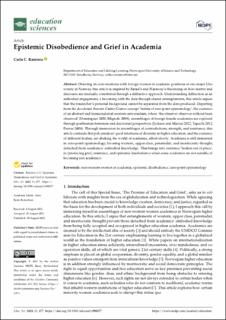| dc.description.abstract | Drawing on conversations with foreign women in academic positions at one major University in Norway, this article is inspired by Barad’s and Haraway’s theorizing on how matter and discourse are mutually constituted through a diffractive approach. Understanding diffraction as an embodied engagement, a becoming with the data through shared entanglements, this article argues that the researcher’s personal background cannot be separated from the data produced. Departing from the decolonial theorist Castro-Gómez concept ‘hubris of zero-point epistemology’, the existence of an abstract and transcendental western universalism, where ‘the observer observes without been observed’ (Domínguez 2020; Mignolo 2009), assemblages of foreign female academics are explored through posthuman feminism and decolonial perspectives (Jackson and Mazzei 2012; Taguchi 2012; Puwar 2004). Through immersion in assemblages of contradictions, strength, and resistance, this article contends that policymakers’ good intentions of diversity in higher education, and the existence of different bodies, are shaking the world of academia, albeit slowly. Academia is still immersed in zero-point epistemology, favoring western, upper-class, paternalist, and meritocratic thought, detached from academics’ embodied knowledge. This brings into existence ‘bodies out of place’, re/producing grief, resistance, and epistemic disobedience when some academics are not suitable of becoming real academics. | en_US |

